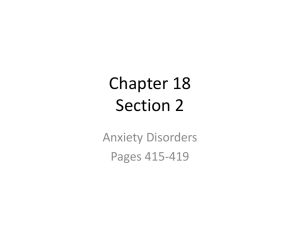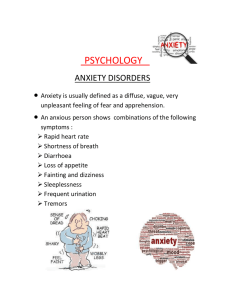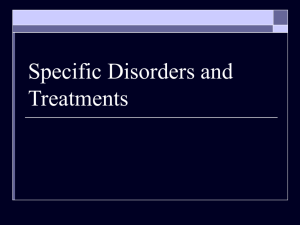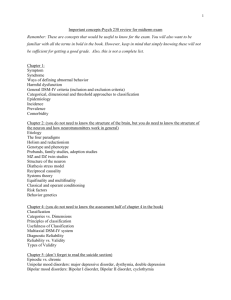Anxiety Disorders PowerPoint
advertisement
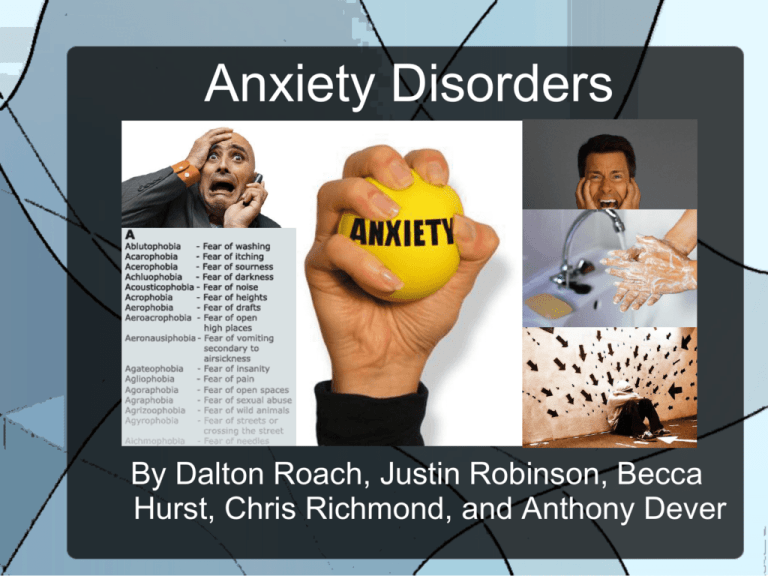
Anxiety Disorders By Dalton Roach, Justin Robinson, Becca Hurst, Chris Richmond, and Anthony Dever What are Anxiety Disorders? The class of mental disorder in which anxiety is the predominant feature. Last at least 6 months Often occurs with other mental or physical illnesses How Many Do They Affect? About 40 million Americans over 18 years of age are affected by anxiety disorders Approximately 18% of population Variations General Anxiety Disorder Phobic Disorders Panic Disorders Obsessive-Compulsive Disorder Generalized Anxiety Disorder by Chris Richmond What Is It? Constant worry or obsession about small or large concerns Restlessness and feeling keyed up on edge Fatigue Difficulty concentrating Irritability Muscle tension/aches Trembling, feeling twitchy or being easily startled Trouble sleeping Sweating, nausea or diarrhea Shortness of breath or rapid heartbeat Risk Factors Complications Being Female Childhood trauma Illness Stress Personality Genetics Substance Abuse Depression Substance Abuse Trouble Sleeping Digestive Problems Headaches Teeth Grinding Diagnosis Phobias Panic Disorder Depression Substance Abuse Post-traumatic Stress Disorder Treatments Pharmacotherapy Antidepressants Buspirone Benzodiazepines Psychotherapy Phobias by Justin Robinson Introduction A phobia is defined as an irrational, intense fear of an object or situation that poses little or no actual danger. More than 10% of Americans suffer from some type of phobia. Causes of Phobias Sometimes it is difficult to know what causes a specific phobia for a person. It is said to occur in children and sometimes a childhood fear stays with the person into adulthood. Traumatic experiences can cause phobias and sometimes phobias can just occur without any significant experience to cause it. 4 Main Types of Phobias Animals – dogs, spiders, snakes, birds, etc. Medical – blood, doctors, dentists, needles, or other medical objects. Natural Environment – storms, water, or other natural objects. Situational – heights, driving, elevators, cooking, or other specific situations. Symptoms Terror: A persistent and overwhelming fear of the object or situation. Physical Symptoms: Dizziness, shaking, palpitations. Obsessive Thoughts: Difficulty thinking about anything other than the fear. Desire to Flee: An intense instinct to leave the situation. Anticipatory Anxiety: Persistent worrying about upcoming events that involve the phobic object or situation. Statistics Americans by Millions Anxiety Disorders 19.1 Social Phobia 5.2 Agoraphobia 3.2 Specific Phobias 6.2 Treatment and Cure The most effective treatment is what is called exposure therapy, which means to expose the individual to the fear in steps and repeatedly facing the fear until the individual is no longer afraid of that specific object or situation. Panic Disorder by Becca Hurst Panic Disorder The sudden occurrence of multiple psychological and physiological symptoms that contribute to a feeling of stark terror. Approximately 8% to 12% of the U.S. population reports having occasional panic attacks. Usually happening in a period of intense stress. Women are twice as likely to be diagnosed with panic attack than men. Hereditary component to panic disorder. Characteristics Panic Attack Lasts a few minutes Shortness of breath Heart palpitations Sweating Dizziness Fear one is going crazy Fear one is about to die Types • • Panic Disorder is only diagnosed if a panic attack is recurrent unexpected attacks and reports significant dread and anxiety about another attack Agoraphobia – specific phobic involving a fear of venturing into public places. – Not afraid of public places but fear of having a panic attack in public Treatment Medications Examples: Klonopin, Ativan, Valium, and Xanax. Immediately calming and reduce intensity of symptoms. Side effect: drowsiness. Psychotherapy Cognitive behavioral therapy Supportive therapy Exploratory therapy Obsessive Compulsive Disorder by Anthony Obsessive Compulsive Disorder (OCD) Defined as: An anxiety disorder in which people have unwanted and repeating thoughts, feelings, Ideas sensations (obsessions) or behaviors that make them feel driven to do something. Anthony Categories of OCD Anthony Washers: Afraid of contamination. Have cleaning and hand-washing compulsions. Checkers: Repeatedly check things that they associate with harm or danger. Doubters & Sinners: Afraid that if everything is not perfect or done just right something bad will happen or they will be punished. Counters & Arrangers: Obsessed with order and symmetry. Hoarders: Fear something bad will happen if they throw something away. They hoard things they don’t need or use. Treatments Medications: SSRI’S Citalopram Fluoxetine Fluvoxamine Paroxetine Sertraline (Celexa) (Prozac) (Luvox) (Paxil) (Zoloft) Exposure and Response Prevention Cognitive Therapy (CBT) Anthony Conclusion Anxiety disorders are treatable Limitations of study Questions? References Melinda Smith, M.A., Robert Segal, M.A., and Jeanne Segal, Ph.D. (2012). Fears and Phobias. Retrieved April 18, 2012 from, http://www.helpguide.org/mental/phobia_symptoms_types_treatment.htm Fritscher, Lisa. (2012) Phobias. Retrieved April 18, 2012, from http://phobias.about.com/ http://www.phobias-help.com/ Cape, J.; Chan, M.; Lovell, K.; Leibowitz, J.; Kendall, T. (2011) Management of generalized anxiety disorder; the updated NICE guideline. Healthcare Counseling & Psychotherapy Journal 11(2), 12-6. Dalrymple, K. (2007) Acceptance and Commitment Therapy for Generalized Social Anxiety Disorder. Behavior Modification 31(5), 543-568. Depression and generalized anxiety disorder. (2009). Formulary, 44(1), 28. Generalized anxiety disorder: People who worry about everything--and nothing in particular--have several treatment options. (2011). Harvard Mental Health Letter 27(12), 1-3. References National institute of mental health. (2009). Retrieved from http://www.nimh.nih.gov/health/publications/anxiety-disorders/nimhanxiety.pdf Schacter, D. L., Gilbert, D. T., & Wegner, D. M. (2011).Introducing psychology. (1st Ed. ed.). New York, NY: Worth Publishers. Understanding anxiety disorders and effective fyi treatment [Web log message]. (2010, June). Retrieved from http://www.apapracticecentral.org/outreach/anxiety-disorders.pdf

